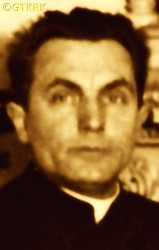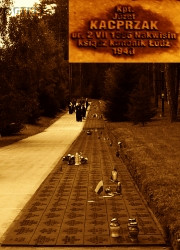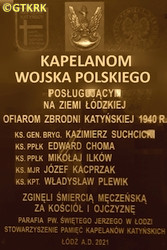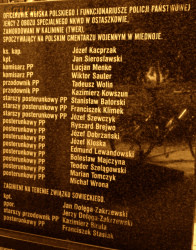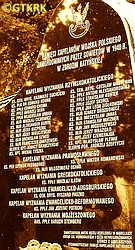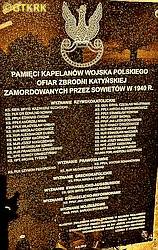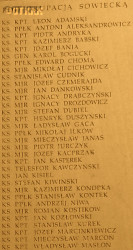Roman Catholic
St Sigismund parish
05-507 Słomczyn
85 Wiślana Str.
Konstancin deanery
Warsaw archdiocese, Poland
full list:
displayClick to display full list

searchClick to search full list by categories
wyświetlKliknij by wyświetlić pełną listę po polsku

szukajKliknij by przeszukać listę wg kategorii po polsku

Martyrology of the clergy — Poland
XX century (1914 – 1989)
personal data
surname
KACPRZAK
surname
versions/aliases
KASPRZAK
forename(s)
Joseph (pl. Józef)
function
diocesan priest
creed
Latin (Roman Catholic) Church RCmore on
en.wikipedia.org
[access: 2014.09.21]
diocese / province
Łódź diocesemore on
en.wikipedia.org
[access: 2013.05.19]
Warsaw archdiocesemore on
en.wikipedia.org
[access: 2013.05.19]
RC Military Ordinariate of Polandmore on
en.wikipedia.org
[access: 2014.12.20]
honorary titles
Rochettum et Mantolettum canonmore on
Rochettum et Mantolettum canon
(1933)
honorary canonmore on
honorary canon
(1933, St Stanislav Kostka the Confessor RC cathedral church, Łódźtoday: Łódź city pov., Łódź voiv., Poland
more on
en.wikipedia.org
[access: 2021.07.18])
War Order of Virtuti Militari — Silver (5th Class)more on
War Order of Virtuti Militari – Silver (5th Class)
(11.11.1976, Londontoday: London Cou., England, United Kingdom
more on
en.wikipedia.org
[access: 2024.03.19], decree of Stanislav Ostrowski, President of the Republic of Poland in exile)
September Campaign Crossmore on
September Campaign Cross
(01.01.1986, Londontoday: London Cou., England, United Kingdom
more on
en.wikipedia.org
[access: 2024.03.19], decision of George Premyslav Morawicz, Minister of Military Affairs of the Polish Government in exile)
date and place
of death
29.04.1940

NKVD TverHQ at 17 4 Sovetskaya Str
today: Tver Medical Institute, Tver oblast, Russia
more on
en.wikipedia.org
[access: 2021.10.09]
alt. dates and places
of death
30.04.1940, 01.05.1940
details of death
From 08.1914 to 10.07.1915, during World War I, chaplain of the Russian Imperial Empire. His Sochaczew parish found itself on the front line of German–Russian fighting as early as 09.1914. The town changed hands several times, including during the so‐called Battle of Sochaczew on 03‐05.10.1914. On c. 27.10.1914, the Russians retook the city, and in 12.1914, after the Battle of Łódź, it once again became a frontline city. At that time, served as chaplain on the line Młodzieszyn – Sochaczew – Bolimów. On 31.01.1915, in the battles of Bolimów, the Germans successfully used poisonous gases for the first time. In Sochaczew, 64% of the buildings were completely destroyed, and the total number of those damaged reached 85%. A large part, if not the majority, of the front units on both sides in these positional battles were Poles. Ended his ministry after the defeat of the Russians in the Battle of Gorlice in 05.1915 and after the escape of the Russians — c. 3 million representatives of the Russian bureaucratic and military apparatus, teachers, Orthodox clergy, etc., fled from the territories of the Rus. Царство Польское (Eng. Kingdom of Poland), i.e. Russian partition of Poland (so‐called bezhenstvo) — and capture of Sochaczew by the Germans on 17.07.1917.
During Polish–Russian war of 1919‐1921 prob. a chaplain–volunteer of the Polish Army — in captain rank.
In the summer of 1939 on holidays and after the German invasion of Poland on 01.09.1939 (the Russians attacked Poland 17 days later) and the start of World War II, prob. mobilized into Polish Army.
Left Łódź and evacuated to eastern Poland with a group of policemen.
After start of the Russian occupation, i.e. after 17.09.1939, arrested by the Russians in Volyn, in Verba town c. 20 km sout of Dubno.
Held in the NKVD filtration camp PFL Shepetivka.
On 01.11.1939 transported to the KLW Ostashkov concentration camp.
From there — his name is on the NKVD deportation list No. 051/1 of 27.04.1940, item 4 (case No. 5048/119), with an order to be placed at the disposal of the head of the NKVD Directorate in Tver — on 28.04.1940 or 29.04.1940 transported to Tver execution site and brutally murdered.
By Polish Minister of Defence’s decision No. 439/MON of 05.10.2007 posthumously promoted to the rank of major.
prisoner camp's numbers
5048/119 (KLW OstashkovClick to display the description)
cause of death
mass murder
perpetrators
Russians
sites and events
NKVD TverClick to display the description, «Katyn genocide 1940»Click to display the description, KLW OstashkovClick to display the description, PFL ShepetivkaClick to display the description, Ribbentrop‐MolotovClick to display the description, Pius XI's encyclicalsClick to display the description, Łódź (Sterling Str.)Click to display the description, Polish‐Russian war of 1919‐1921Click to display the description
date and place
of birth
02.07.1886Birth certification on:
photos.szukajwarchiwach.gov.pl
[access: 2025.08.19]

Nakwasintoday: Mała Wieś gm., Płock pov., Masovia voiv., Poland
more on
en.wikipedia.org
[access: 2022.01.28]
alt. dates and places
of birth
02.08.1886
parents
KACPRZAK Thomas
🞲 ?, ? — 🕆 ?, ?

GOLATOWSKA Mary
🞲 ?, ? — 🕆 ?, ?
baptism
03.07.1886Birth certification on:
photos.szukajwarchiwach.gov.pl
[access: 2025.08.19]

Orszymowotoday: Mała Wieś gm., Płock pov., Masovia voiv., Poland
more on
en.wikipedia.org
[access: 2021.12.18]
Our Lady of the Rosary RC church
presbyter (holy orders)
ordination
20.07.1913

Warsawtoday: Warsaw city pov., Masovia voiv., Poland
more on
en.wikipedia.org
[access: 2021.10.09]
Holy Cross RC churchmore on
en.wikipedia.org
[access: 2017.01.21]
positions held
1932 – 1939
chaplain — Łódźtoday: Łódź city pov., Łódź voiv., Poland
more on
en.wikipedia.org
[access: 2021.07.18] ⋄ 16 Sterlinga Str. Prison
1930 – 1939
chaplain — Łódźtoday: Łódź city pov., Łódź voiv., Poland
more on
en.wikipedia.org
[access: 2021.07.18] ⋄ St Mary Magdalene City Hospital (at 17 Tramwajowa Str.) — also: i.a. chaplain of „Nursery” asylum for abandoned children (c. 1930‐1932) and other charitable institutions in buildings at 13‐15 Tramwajowa Str., Stephen Żeromski's Municipal Educational Home (from 1930), prefect of Emilia Szczaniecka's State Gymnasium and lyceum for Girls (1938‐1939), State Commerce School for Men (c. 1937‐1939), municipal further educatoin and vocational evening schools and elementary schools (e.g. at Suwalska Str.)
1934 – 1937
church assistant — Catholic Association of Male Youth KSMM ⋄ Łódź RC diocese
1929 – 1930
parish priest — Gałkówtoday: Gałków Duży, Koluszki gm., Łódź‐east pov., Łódź voiv., Poland
more on
en.wikipedia.org
[access: 2022.07.16] ⋄ Holy Trinity RC parish ⋄ Brzezinytoday: Brzeziny urban gm., Brzeziny pov., Łódź voiv., Poland
more on
en.wikipedia.org
[access: 2020.11.27] RC deanery
1927 – 1929
parish priest — Tumtoday: Góra Świętej Małgorzaty gm., Łęczyca pov., Łódź voiv., Poland
more on
en.wikipedia.org
[access: 2022.01.28] ⋄ Blessed Virgin Mary and St Alexius RC collegiate parish ⋄ Łęczycatoday: Łęczyca urban gm., Łęczyca pov., Łódź voiv., Poland
more on
en.wikipedia.org
[access: 2021.12.18] RC deanery
1924 – 1927
chaplain — Łęczycatoday: Łęczyca urban gm., Łęczyca pov., Łódź voiv., Poland
more on
en.wikipedia.org
[access: 2021.12.18] ⋄ prison
1924 – 1927
vicar — Łęczycatoday: Łęczyca urban gm., Łęczyca pov., Łódź voiv., Poland
more on
en.wikipedia.org
[access: 2021.12.18] ⋄ St Andrew the Apostle RC parish (main parish) ⋄ Łęczycatoday: Łęczyca urban gm., Łęczyca pov., Łódź voiv., Poland
more on
en.wikipedia.org
[access: 2021.12.18] RC deanery — also: prefect of primary schools, 8‐grade Humanities Gymnasium for Girls and Fr Gregory Piramowicz's State Teachers' Seminary for Men
1922 – 1924
vicar — Zgierztoday: Zgierz urban gm., Zgierz pov., Łódź voiv., Poland
more on
en.wikipedia.org
[access: 2021.12.18] ⋄ St Catherine of Alexandria the Virgin and Martyr RC parish ⋄ Łódź extra Urbemdeanery name
today: Łódź voiv., Poland RC deanery — also: prefect of elementary schools, and Teachers' Seminary for Women
1918 – 1922
vicar — Tomaszów Mazowieckitoday: Tomaszów Mazowiecki urban gm., Tomaszów Mazowiecki pov., Łódź voiv., Poland
more on
en.wikipedia.org
[access: 2021.09.29] ⋄ St Anthony of Padua RC parish ⋄ Tomaszów Mazowieckitoday: Tomaszów Mazowiecki urban gm., Tomaszów Mazowiecki pov., Łódź voiv., Poland
more on
en.wikipedia.org
[access: 2021.09.29] RC deanery — also: prefect of primary schools, including the 7‐grade Public School, the State Teachers' Seminary and the 8‐grade Real School
1917 – 1918
vicar — Powsintoday: neighborhood in Wilanów district in Warsaw, Warsaw city pov., Masovia voiv., Poland
more on
en.wikipedia.org
[access: 2022.07.16] ⋄ St Elizabeth of Hungary RC parish ⋄ Warsaw‐extra‐Urbemdeanery name
today: Warsaw city pov., Masovia voiv., Poland RC deanery
1915 – 1917
vicar — Łowicztoday: Łowicz urban gm., Łowicz pov., Łódź voiv., Poland
more on
en.wikipedia.org
[access: 2021.12.18] ⋄ Assumption of the Blessed Virgin Mary and St Nicholas the Bishop and Confessor RC collegiate parish ⋄ Łowicztoday: Łowicz urban gm., Łowicz pov., Łódź voiv., Poland
more on
en.wikipedia.org
[access: 2021.12.18] RC deanery
1914 – 1915
RC military chaplain — Sochaczewtoday: Sochaczew gm., Sochaczew pov., Masovia voiv., Poland
more on
en.wikipedia.org
[access: 2021.03.16] ⋄ Imperial Russian Army
1914 – 1915
vicar — Sochaczewtoday: Sochaczew gm., Sochaczew pov., Masovia voiv., Poland
more on
en.wikipedia.org
[access: 2021.03.16] ⋄ St Lawrence the Deacon and Martyr RC parish ⋄ Sochaczewtoday: Sochaczew gm., Sochaczew pov., Masovia voiv., Poland
more on
en.wikipedia.org
[access: 2021.03.16] RC deanery
1913 – 1914
vicar — Dobretoday: Dobre gm., Mińsk Mazowiecki pov., Masovia voiv., Poland
more on
en.wikipedia.org
[access: 2021.03.16] ⋄ St Nicholas the Bishop and Confessor RC parish ⋄ Radzymintoday: Radzymin gm., Wołomin pov., Masovia voiv., Poland
more on
en.wikipedia.org
[access: 2022.01.10] RC deanery
1913
vicar — Cygówtoday: Poświętne gm., Wołomin pov., Masovia voiv., Poland
more on
en.wikipedia.org
[access: 2022.07.21] ⋄ St John the Baptist and St Adalbert the Bishop and Martyr RC parish ⋄ Radzymintoday: Radzymin gm., Wołomin pov., Masovia voiv., Poland
more on
en.wikipedia.org
[access: 2022.01.10] RC deanery
1907 – 1913
student — Warsawtoday: Warsaw city pov., Masovia voiv., Poland
more on
en.wikipedia.org
[access: 2021.10.09] ⋄ philosophy and theology, Metropolitan Theological Seminary
others related
in death
DUBIELClick to display biography Alexander, JANASClick to display biography Mieczyslav, MARCOŃClick to display biography Mieczyslav, MASŁOŃClick to display biography Vladislav, MIKUCZEWSKIClick to display biography Joseph, MIODUSZEWSKIClick to display biography John, NOWAKClick to display biography Edmund, OCHABClick to display biography Vladimir, PASZKOClick to display biography Richard, ROMANOWSKIClick to display biography Victor, SKORELClick to display biography Joseph, SZWEDClick to display biography Bronislav, WOJTYNIAKClick to display biography Ceslav, ZAKRZEWSKIClick to display biography Francis
sites and events
descriptions
NKVD Tver: On 04.04‐22.05.1940 the Russians executed in NKVD HQ building at 4 Sovetskaya Str (now Tver Medical Institute) in Tver c. 6,314 Polish prisoners of war (POW) kept in KLW Ostashkov concentration camp in Ostashkov. This genocide was the implementation of the decision of the Russian Commie‐Nazi authorities — the Politburo of the Russian Commie‐Nazi party — of 05.03.1940 to exterminate tens of thousands of Polish intelligentsia and servicemen, held in Russian camps established after the German‐Russian Ribbentrop‐Molotov Agreement and the annexation of half of Poland by the Russians in 1939, known as «Katyn genocide». After the formal „verdict”, the NKVD Special Council Moscow, i.e. the genocidal Russian kangaroo court known as the «NKVD Troika», sent successive disposition letters to the NKVD in Tver — there were c. 60 of them — containing the names of the persons to be murdered. The prisoners were brought — Tver is c. 190 km from Ostashkov — to the NKVD HQ building, identified one by one in a basement room known as the „Lenin’s room”, handcuffed, taken to another room cellar with a door covered with felt, and then murdered individually by a shot from a German Walther P38 pistol into the back of the head. The bodies where next dumped into mass graves in ditches in the Miednoje forest, in the NKVD summer resort, and covered with sand by an excavator. (more on: pl.wikipedia.orgClick to attempt to display webpage
[access: 2012.11.23], en.wikipedia.orgClick to attempt to display webpage
[access: 2014.05.09])
«Katyn genocide 1940»: 05.03.1940, the Russian Commie‐Nazi authorities — the Politburo of the Russian Commie‐Nazi party headed by Joseph Stalin — made a formal, secret decision No. P13/144 to exterminate tens of thousands of Polish intelligentsia and military personnel, „declared and hopeless enemies of the Russian government”, held in Russian camps, as a consequence of the German‐Russian Ribbentrop‐Molotov Agreement, the invasion of Poland and annexation of half of Poland in 09.1939, and the beginning of World War II. The decision was, as it were, „sanctioned” by the verdicts of the NKVD Special Council, i.e. the genocidal Russian kangaroo court known as «NKVD Troika» in Moscow. The implementation in Ukraine and Belarus was made possible by order No. 00350 of 22.03.1940 of the head of the NKVD, Lavrentiy Beria, on the „unloading of NKVD prisons”, i.e. transfer of prisoners from several prisons in Ukraine and Belarus to central prisons, e.g. in Kiev or Minsk. The genocidal «NKVD Troika», after issuing sentences, also sent to local NKVD units, NKVD disposition lists — i.e. lists of convicts — each containing on average c. 100 names. Named lists are known — may be reconstructed — for people held in the KLW Kozelsk and KLW Ostashkov camps, but not for KLW Starobilsk, known for victims from Ukrainian prisons, but not Belarusian ones. It is not even known exactly how many lists there were, mainly because the number of them sent to the NKVD in Belarus is unknown. On 03.03.1959 Alexander Shelepin, then head of the Russian KGB, in a handwritten note stated: „ Since 1940, the Committee for State Security under the Council of Ministers of Russia, has been keeping records and other materials relating to the prisoners of war and interned officers, gendarmes, policemen, etc., people from former bourgeois Poland shot that year. In total, based on the decision of the special troika of the NKVD of the USSR, 21,857 people were shot, of whom: 4,421 people in the Katyn Forest (Smolensk Oblast), 3,820 people from the Starobilsk camp near Kharkov, 6,311 people from the Ostashkov camp (Kalinin Oblast), and 7,305 people in other camps and prisons in Western Ukraine and Western Belarus. The entire operation of liquidation of the above–mentioned was carried out on the basis of the Resolution of the Central Committee of the CPSU of 05.03.1940”. The head of the NKVD recommended to the Russian leader, Nikita Khrushchev, to destroy all personal files of those shot in 1940, but to keep the minutes of the meetings of the «NKVD Troika» and confirmations of the implementation of the decisions of the «NKVD Troika». A one–sentence draft resolution was attached to the note. It is not known whether the resolution was accepted and whether the files were destroyed. The aforementioned protocols and confirmations of the «NKVD Troika» are also not known. There are indications — i.e. four so‐called „NKVD‐Gestapo Methodical Conferences” of 1939‐1940: in Brest on Bug, Przemyśl, Zakopane and Cracow — of close collaboration between Germans and Russians in realization of plans of total extermination of Polish nation, its elites in particular — decision that prob. was confirmed during meeting of socialist leaders of Germany: Mr Heinrich Himmler, and Russia: Mr Lavrentyi Beria, in another German leader, Mr Hermann Göring, hunting lodge in Rominty in Romincka Forest in East Prussia. (more on: en.wikipedia.orgClick to attempt to display webpage
[access: 2023.12.15])
KLW Ostashkov: Russian Rus. Концентрационный Лагерь для Военнопленных (Eng. POW Concentration Camp) KLW, run by genocidal Russian NKVD organization, for Poles arrested after the invasion in 1939, operating in 1939‐1940 in Ostashkov — in practice on Seliger lake Stolbnoy island and Svetlitsa peninsula, c. 11 km from Ostashkov, in a former Orthodox monastery, Niłowo‐Stołobieńska Hermitage, looted and shut down by Russian Bolsheviks in 1928. In 04.1940 6,570 were held captive there (in 11.1940 — 8397), out of which c. 6,300 were subsequently — as the fulfillment of Russian government decision to exterminate Polish intelligentsia and prisoners of war camps (Polish holocaust) — executed in Tver. Among the victims were officers of the Polish State Police, the Border Protection Corps KOP, Military Police, the Prison Service, officers and soldiers of the Polish Army, intelligence and counterintelligence officers of the Second Department of the General Staff, priests, employees of the judiciary, the fire brigade, foresters and military settlers from the eastern part of the Second Polish Republic. On another island of Lake Seliger, Gorodomla, in 1946‐1953 the Russians held a group of German specialists from Wernher von Braun's team, who, under the direction of Sergei Korolev, worked on Russian missiles. (more on: pl.wikipedia.orgClick to attempt to display webpage
[access: 2012.11.23])
PFL Shepetivka: Russian Rus. Проверочно‐Фильтрационный Ла́герь (Eng. Testing and Filtration Camp) PFL, where the genocidal Russian NKVD organization carried out selection and isolation of the most „dangerous” or most valuable prisoners — established after the Russian invasion of Poland on 17.09.1939, the establishment of the NKVD Board for Prisoners of War and Internees on 19.09.1939 by the head of the NKVD, Lavrenty Beria, and the order to establish a number of camps for Polish POWs. Operated in 1939‐1940 in Shepetivka, village on the then Polish Ukraine. C. 20,000 prisoners — Polish intelligentsia and soldiers — were held there in extremely harsh conditions: POWs had to sleep on the earth, without food, having to queue few hours for a glass of water. Next POWs were sent to Russian concentration camps and then to mass execution sites. (more on: pl.wikipedia.orgClick to attempt to display webpage
[access: 2013.12.04])
Ribbentrop‐Molotov: Genocidal Russian‐German alliance pact between Russian leader Joseph Stalin and German leader Adolf Hitler signed on 23.08.1939 in Moscow by respective foreign ministers, Mr. Vyacheslav Molotov for Russia and Joachim von Ribbentrop for Germany. The pact sanctioned and was the direct cause of joint Russian and German invasion of Poland and the outbreak of the World War II in 09.1939. In a political sense, the pact was an attempt to restore the status quo ante before 1914, with one exception, namely the „commercial” exchange of the so‐called „Kingdom of Poland”, which in 1914 was part of the Russian Empire, fore Eastern Galicia (today's western Ukraine), in 1914 belonging to the Austro‐Hungarian Empire. Galicia, including Lviv, was to be taken over by the Russians, the „Kingdom of Poland” — under the name of the General Governorate — Germany. The resultant „war was one of the greatest calamities and dramas of humanity in history, for two atheistic and anti‐Christian ideologies — national and international socialism — rejected God and His fifth Decalogue commandment: Thou shall not kill!” (Abp Stanislav Gądecki, 01.09.2019). The decisions taken — backed up by the betrayal of the formal allies of Poland, France and Germany, which on 12.09.1939, at a joint conference in Abbeville, decided not to provide aid to attacked Poland and not to take military action against Germany (a clear breach of treaty obligations with Poland) — were on 28.09.1939 slightly altered and made more precise when a treaty on „German‐Russian boundaries and friendship” was agreed by the same murderous signatories. One of its findings was establishment of spheres of influence in Central and Eastern Europe and in consequence IV partition of Poland. In one of its secret annexes agreed, that: „the Signatories will not tolerate on its respective territories any Polish propaganda that affects the territory of the other Side. On their respective territories they will suppress all such propaganda and inform each other of the measures taken to accomplish it”. The agreements resulted in a series of meeting between two genocidal organization representing both sides — German Gestapo and Russian NKVD when coordination of efforts to exterminate Polish intelligentsia and Polish leading classes (in Germany called «Intelligenzaktion», in Russia took the form of Katyń massacres) where discussed. Resulted in deaths of hundreds of thousands of Polish intelligentsia, including thousands of priests presented here, and tens of millions of ordinary people,. The results of this Russian‐German pact lasted till 1989 and are still in evidence even today. (more on: en.wikipedia.orgClick to attempt to display webpage
[access: 2015.09.30])
Pius XI's encyclicals: Facing the creation of two totalitarian systems in Europe, which seemed to compete with each other, though there were more similarities than contradictions between them, Pope Pius XI issued in 03.1937 (within 5 days) two encyclicals. In the „Mit brennender Sorge” (Eng. „With Burning Concern”) published on 14.03.1938, condemned the national socialism prevailing in Germany. The Pope wrote: „Whoever, following the old Germanic‐pre‐Christian beliefs, puts various impersonal fate in the place of a personal God, denies the wisdom of God and Providence […], whoever exalts earthly values: race or nation, or state, or state system, representatives of state power or other fundamental values of human society, […] and makes them the highest standard of all values, including religious ones, and idolizes them, this one […] is far from true faith in God and from a worldview corresponding to such faith”. On 19.03.1937, published „Divini Redemptoris” (Eng. „Divine Redeemer”), in which criticized Russian communism, dialectical materialism and the class struggle theory. The Pope wrote: „Communism deprives man of freedom, and therefore the spiritual basis of all life norms. It deprives the human person of all his dignity and any moral support with which he could resist the onslaught of blind passions […] This is the new gospel that Bolshevik and godless communism preaches as a message of salvation and redemption of humanity”… Pius XI demanded that the established human law be subjected to the natural law of God , recommended the implementation of the ideal of a Christian state and society, and called on Catholics to resist. Two years later, National Socialist Germany and Communist Russia came together and started World War II. (more on: www.vatican.vaClick to attempt to display webpage
[access: 2023.05.28], www.vatican.vaClick to attempt to display webpage
[access: 2023.05.28])
Łódź (Sterling Str.): Prison for men, founded in 1893, in a tenement houses at 16/18 Sterling Str. in Łódź, by the Russian occupiers (during partitions of Poland). In the interwar period, a Polish state prison. During World War II, a German police prison, used also by the Germ. Geheime Staatspolizei (Eng. Secret State Police), i.e. Gestapo. The prisoners were held in two three‐story buildings with 53 cells and 5 „sick rooms”. Interrogations of arrested Poles, combined with torture, as well as executions ‐ by hanging — were held there. After the German defeat and the beginning of the Russian occupation, the prison of the Commie‐Nazi of State Security Office UB — the unit of Russian genocidal MGB. Executions continued to take place there, this time of Germans and Poles convicted of collaborating with the German occupier, as well as of those convicted of anti‐communist activities and ordinary criminals. Closed in 1964. (more on: pl.wikipedia.orgClick to attempt to display webpage
[access: 2015.09.30])
Polish‐Russian war of 1919‐1921: War for independence of Poland and its borders. Poland regained independence in 1918 but had to fight for its borders with former imperial powers, in particular Russia. Russia planned to incite Bolshevik‐like revolutions in the Western Europe and thus invaded Poland. Russian invaders were defeated in 08.1920 in a battle called Warsaw battle („Vistula river miracle”, one of the 10 most important battles in history, according to some historians). Thanks to this victory Poland recaptured part of the lands lost during partitions of Poland in XVIII century, and Europe was saved from the genocidal Communism. (more on: en.wikipedia.orgClick to attempt to display webpage
[access: 2014.12.20])
sources
personal:
www.ordynariat.wp.mil.plClick to attempt to display webpage
[access: 2013.02.09], dziwoszbogdan.republika.plClick to attempt to display webpage
[access: 2012.12.28], lodz-andrzejow.plClick to attempt to display webpage
[access: 2024.06.10], photos.szukajwarchiwach.gov.plClick to attempt to display webpage
[access: 2025.08.19], www.muzeumtradycji.plClick to attempt to display webpage
[access: 2017.01.21], www.bractwo-wiezienne.warszawa.plClick to attempt to display webpage
[access: 2013.01.17]
bibliographical:
„Lexicon of Polish clergy repressed in USSR in 1939‐1988”, Roman Dzwonkowski, SAC, ed. Science Society KUL, 2003, Lublin
original images:
nekropole.infoClick to attempt to display webpage
[access: 2017.01.21], www.moremaiorum.plClick to attempt to display webpage
[access: 2018.09.02], panaszonik.blogspot.comClick to attempt to display webpage
[access: 2013.12.04], rzeszow.ipn.gov.plClick to attempt to display webpage
[access: 2023.12.15], panaszonik.blogspot.comClick to attempt to display webpage
[access: 2014.11.02], radio.lublin.plClick to attempt to display webpage
[access: 2022.05.23], ofm.krakow.plClick to attempt to display webpage
[access: 2022.05.23], www.katedrapolowa.plClick to attempt to display webpage
[access: 2014.01.16], ipn.gov.plClick to attempt to display webpage
[access: 2019.02.02], lodz-andrzejow.plClick to attempt to display webpage
[access: 2024.06.16]
LETTER to CUSTODIAN/ADMINISTRATOR
If you have an Email client on your communicator/computer — such as Mozilla Thunderbird, Windows Mail or Microsoft Outlook, described at WikipediaPatrz:
en.wikipedia.org, among others — try the link below, please:
LETTER to CUSTODIAN/ADMINISTRATORClick and try to call your own Email client
If however you do not run such a client or the above link is not active please send an email to the Custodian/Administrator using your account — in your customary email/correspondence engine — at the following address:

giving the following as the subject:
MARTYROLOGY: KACPRZAK Joseph
To return to the biography press below:
 Click to return to biography
Click to return to biography








